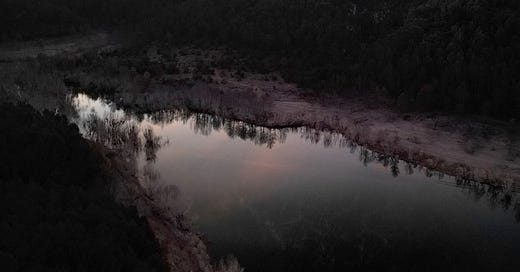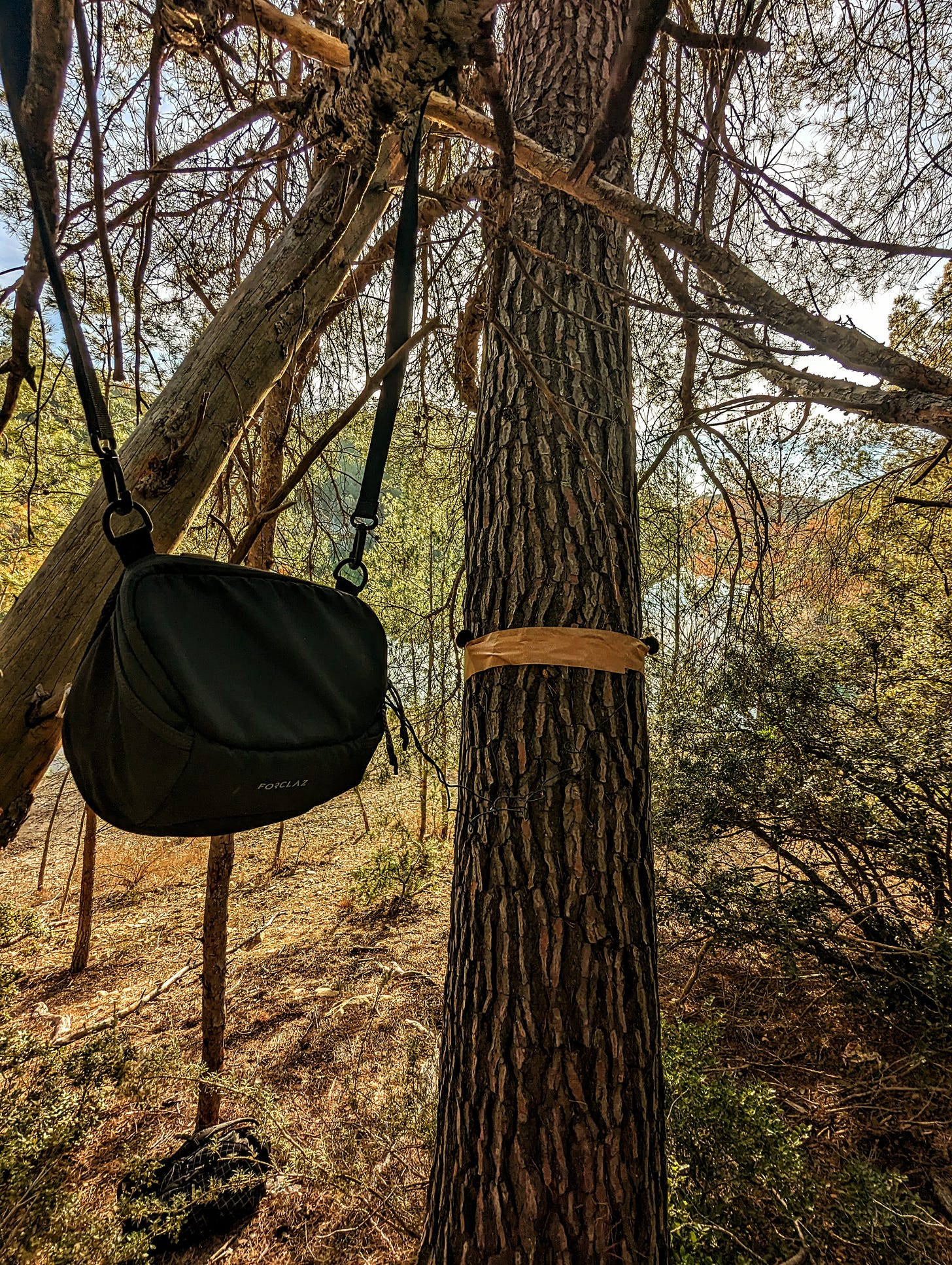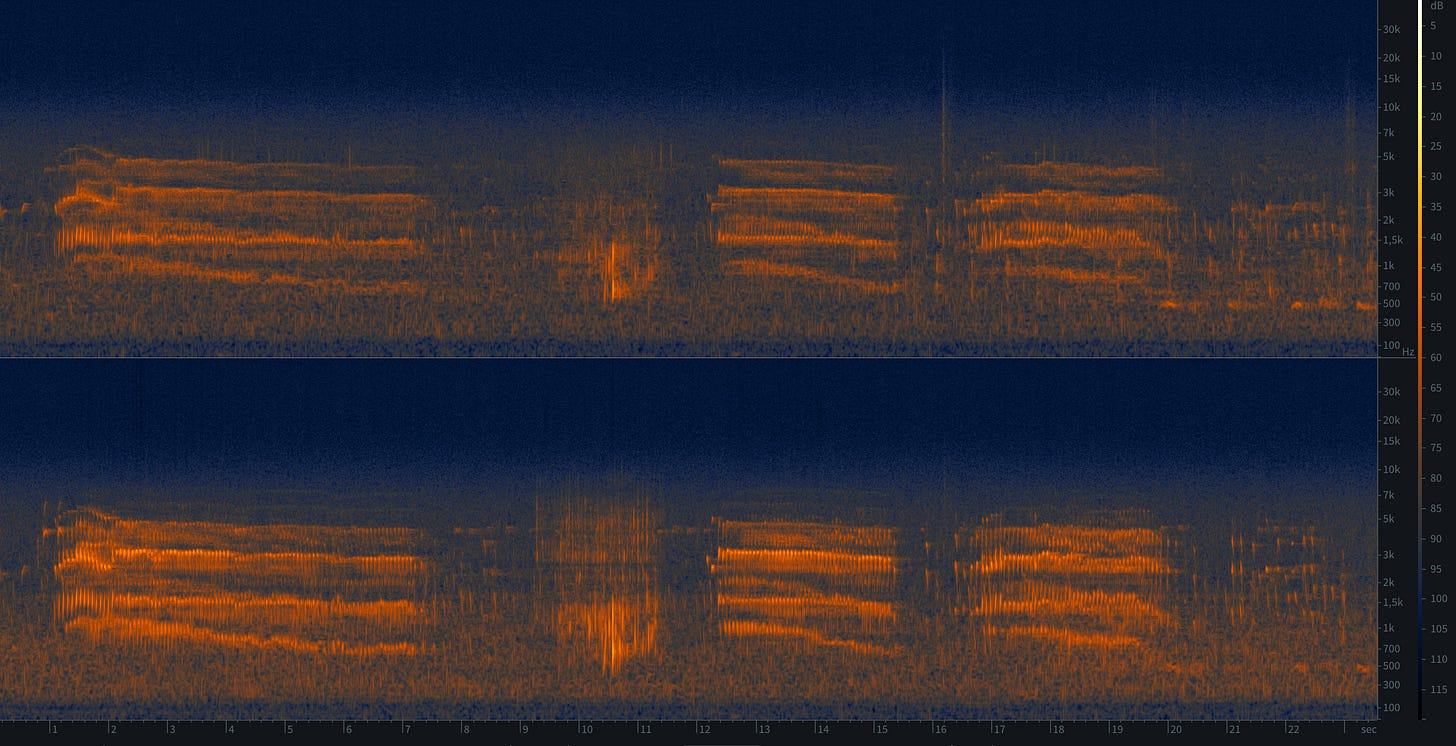Nightscapes : Nocturnal Sounds from a Forest Lake
What lurks and lingers amongst the pines out there in the deep dark of night...
I count myself lucky to live close to the forest.
I’ve always felt that any open green space offers an opportunity for discovery, immersion, relaxation and wonder…
Pictured above is Lac de Bimont — known also by its more mysterious name "lac perdu" or Lost Lake. A dammed (not damned…I hope…) lake located in the Bouches-du-Rhône region of Provence, sitting quietly at the heart of the Sainte-Victoire massif.
The aerial photo above was taken just a few days ago by my dear friend and fellow adventurer - Gaetan Hutter. We arrived here at 7am, with a temperature at -4°C, to carry out our first cold dip of the year. Through Gaetan’s friendship and guidance, I have really warmed, literally, to the act of intentionally submersing myself in cold water.
Each body of water we have encountered — be it river, sea or glacial lake — presents a different mental and physical challenge; a unique opportunity to really open up and experience a sensory symbiosis with nature. For a very brief moment, a moment that seems much longer when you’re out in the water, you lose track of yourself. Embracing the event horizon of something powerful, something unknown… something so pure it pulls you into a stillness… a silence...
Recently I discovered
by. Gently browsing through her work summons in me the powerful sensations that being present in nature can bring. Somewhere all the senses are soothed. A place we shed the skin of our perceived selves and gently shift into another world.“The tree which moves some to tears of joy is in the eyes of others only a green thing which stands in the way. Some see nature all ridicule and deformity, and by these I shall not regulate my proportions; and some scarce see nature at all. But to the eyes of the man of imagination, nature is imagination itself. As a man is, so he sees.” - William Blake
Since adopting the practice of field recording as a mode de vie, my perception, interaction and integration with my surroundings have become influenced, it seems almost unconsciously, by this craft. My objective has a beautiful simplicity — seeking to observe and record nature in its natural state. The Indian poet Rabindranath Tagore once wrote:
The path to finding and experiencing this reality as a sound recordist, one that is free from the hums, drums and drones of our Anthropocene age — this, it turns out, is one of the greatest challenges that constantly remind us of the limitations that threaten the preservation of quiet, constructing a barrier that suppresses our kinship with Nature.
On the eve of my latest cold water immersion adventure, the thought came to me to set out that evening, just before sunrise, to set up a drop-rig in order to capture the nocturnal sounds of the forest surrounding Lac de Bimont. A drop-rig (pictured above) is an incredibly effective way to record sounds in the wild over long periods of time without having to commit to remaining on location.
I use the Tree Ears recording technique - which involves taping 2 omnidirectional microphones (these Lom Uši Pro’s) to each side of a tree trunk. This allows me to place my mics in a wild location that’s not too noticeable to curious passers by - human or otherwise - and is very simple to set up. I recommend using brown packing tape which isn’t too sticky so as not too scalp any bark from our tree friends!
Recording this way has 2 advantages —
1 — you don’t need to set up camp and sleep out all night in freezing conditions!
2 — perhaps most crucially, you don’t interfere with the natural state of the soundscape. No matter how evasive we think we are capable of being, the truth is that out in the wild we are extremely noticeable. We leave tracks and traces, emit heat and pheromones — all of which send signals to the surrounding forest like ripples through water.
After returning to the studio fresh from my cold dip, and with all my gear in tact, it’s time to transfer almost 16 hours worth of recording material (that’s 32gb recording at 96kHz/24-bit for those interested!). I import my files into Izotope RX — an extremely powerful audio analysis and editing tool — for the uninitiated, imagine a Photoshop for sound files.
Firstly, I’m going to take a look at the recordings to see if I can notice any patterns…
Patterns can show us significant audible events - the calls of different animals such as this one for example. Notice the accented orange markings below…
Now let’s take a listen…
Appearing just as dusk was falling, this is the territorial trill of the curious little grebe. A small water bird The little grebe's breeding call, given singly or in duet, is a trill repeated weet-weet-weet or wee-wee-wee which sounds like a horse whinnying.
If you’re curious about learning more about bird species & sounds I recommend visiting Xenocanto. An incredible website dedicated to sharing wildlife sounds from all over the world. You can even contribute your own recordings. All in the spirit of sharing and promoting knowledge and appreciation for creatures great and small.
Here we have a more seldom seen prowler of the night…
Now this one is special. Listen to that beautiful soft echo…
This is the solitary cry of a lone fox. Male foxes scream to mark their territory and warn off potential competitors for mates. It's also a tool they use to scare off predators and protect their young.
One last creature. This one is easy…
And so my nocturnal soundscape turned out rather tamer than hoped. I’ve combed through the recordings, and on this particular February night it seems our forest lake was a pretty sleepy spot.
There’s been talk in the town recently of wolves reappearing in the forests of Sainte Victoire, and so I had my hopes high that I might just capture proof of their presence.
Something tells me I might have to be a little more patient….
That’s fine by me. I’m certain this spot has many more secrets to share…
Sonic Tapestries will remain free to all subscribers.
Your kind support helps me to grow my audience and continue this path.
If you do like reading along and want to help support my work further, please consider sharing this post with your friends, family and followers.
Thank you for being here with me.
Mat
🌻













Beautiful post. Not a cold dipper (yet), but love the idea.